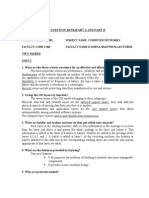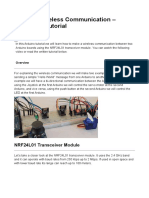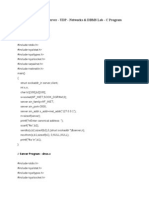Cdma: Code Division Multiple Access (CDMA) Systems Use
Cdma: Code Division Multiple Access (CDMA) Systems Use
Uploaded by
Dinesh Kumar PCopyright:
Available Formats
Cdma: Code Division Multiple Access (CDMA) Systems Use
Cdma: Code Division Multiple Access (CDMA) Systems Use
Uploaded by
Dinesh Kumar POriginal Description:
Original Title
Copyright
Available Formats
Share this document
Did you find this document useful?
Is this content inappropriate?
Copyright:
Available Formats
Cdma: Code Division Multiple Access (CDMA) Systems Use
Cdma: Code Division Multiple Access (CDMA) Systems Use
Uploaded by
Dinesh Kumar PCopyright:
Available Formats
Page
| 1
CDMA:
Code division multiple access (CDMA) systems use
exactly these codes to separate different users in code space
and to enable access to a shared medium without
interference.
A code for a certain user should have a good autocorrelation
and should be orthogonal to other codes.
Two vectors are called orthogonal if their inner product is 0,
as is the case for the two vectors (2, 5, 0 and (0, 0, !"# (2,
5, 0$(0, 0, !" % 0 & 0 & 0 % 0.
'ut also vectors li(e (), *2, + and (*2, ), ) are orthogonal#
(), *2, +$(*2, ), ) % *, * , & !2 % 0.
'y contrast, the vectors (!,2,) and (+,2, *, are not
orthogonal (the inner product is *!0, and (!, 2, ) and (+, 2,
*) are -almost. orthogonal, with their inner product being
*! (which is -close. to /ero.
The 'ar(er code (&!, *!, &!, &!, *!, &!, &!, &!, *!, *!, *!,
for example, has a good autocorrelation, i.e., the inner
product with itself is large, the result is !!. This code is used
for 0123 and 0444 502.!!. 'ut as soon as this 'ar(er code
is shifted ! chip further (thin( of shifting the !! chip 'ar(er
code over itself concatenated several times, the correlation
drops to an absolute value of !.
Two senders, A and ', want to send data. 627A assigns the
following uni8ue and orthogonal (ey se8uences# (ey A( %
0!00!! for sender A, (ey '9 % !!0!0! for sender '. 1ender
A wants to send the bit Ad % !, sender ' sends 'd % 0. To
illustrate this example, let us assume that we code a binary 0
as *!, a binary ! as &!.
Page
| 2
'oth senders spread their signal using their (ey as chipping
se8uence (the term :spreading; here refers to the simple
multiplication of the data bit with the whole chipping
se8uence. 0n reality, parts of a much longer chipping
se8uence are applied to single bits for spreading. 1ender A
then sends the signal As % Ad$A( % &!$(*!, &!, *!, *!, &!,
&! % (*!, &!, *!, *!, &!, &!.
1ender ' does the same with its data to spread the signal
with the code# 's % 'd$'( % *!$(&!, &!, *!, &!, *!, &! %
(*!, *!, &!, *!, &!, *!.
'oth signals are then transmitted at the same time using the
same fre8uency, so, the signals superimpose in space
(analog modulation is neglected in this example.
2iscounting interference from other senders and
environmental noise from this simple example, and
assuming that the signals have the same strength at the
receiver, the following signal 6 is received at a receiver# 6 %
As & 's % (*2, 0, 0, *2, &2, 0.
The receiver now wants to receive data from sender A and,
therefore, tunes in to the code of A, i.e., applies A;s code for
despreading#
C*Ak = (2, , , 2, !2, )*(", !", ", ", !", !")
= 2 ! ! ! 2 ! 2 ! = #$
As the result is much larger than 0, the receiver detects a binary
!. Tuning in to sender ', i.e., applying ';s code gives
C*%k = (2, , , 2, !2, )*(!", !", ", !", ", !")
= 2 ! ! 2 2 ! = #$
The result is negative, so a 0 has been detected.
Page
| 3
Additionally, both spread bits were precisely superimposed
and &oth signals are e'uall( strong when they reach the
receiver. <hat would happen if, for example, ' was much
stronger= Assume that ';s strength is )ive times A*s strength.
Then,
6> % As ! +*%s % (*!, &!, *!, *!, &!, &! & (*5, *5, &5, *5, &5, *
5 % (*,, *+, &+, *,, &,, *+.
Again, a receiver wants to receive
%: C,*%k = # - - # # -= .$
0t is easy to detect the binary 0 sent by '.
3ow the receiver wants to receive
A: C,*Ak = # - - ! # ! # - = #$ , is 8uite close to /ero and
could be interpreted as noise.
Although simplified, this example shows that power control
is essential for 627A systems. /his is one o) the &iggest
pro&lems CDMA s(stems )ace as the power has to be
ad?usted over one thousand times per second in some
systems * this consumes a lot of energy.
@igure ).!+ shows a sender A that wants to transmit the bits !0!.
The (ey of A is shown as signal and binary (ey se8uence A(. 0n
this example, the binary -0. is assigned a positive signal value,
the binary -!. a negative signal value.
After spreading, i.e., ABCing Ad and A(, the resulting signal is
As.
Page
| 4
Page
| 5
A receiver now tries to reconstruct the original data from A,
Ad. Therefore the receiver applies A;s (ey, A(, to the
received signal and feeds the result into an integrator.
The integrator adds the products (i.e., calculates the inner
product, a comparator then has to decide if the result is a 0
or a ! as shown in @igure ).!,. As we can see, although the
original signal form is distorted by ';s signal, the result is
still 8uite clear.
The method wor(s (in theory for arbitrarily different signal
strengths.
0pread Aloha multiple access: (CDMA ! /DMA)
You might also like
- Performance Evaluation Individual ConsultantDocument2 pagesPerformance Evaluation Individual Consultantemillie emilyNo ratings yet
- THR Editor: Owner's ManualDocument10 pagesTHR Editor: Owner's ManualFernando RuffoNo ratings yet
- Electrical Code of The PhilippinesDocument18 pagesElectrical Code of The PhilippinesZen Marl GaorNo ratings yet
- The Secret Life of Vector GeneratorsDocument62 pagesThe Secret Life of Vector GeneratorsMaddy SjiicroNo ratings yet
- Arduino + Processing - Make A Radar Screen To Visualise Sensor Data From SRF-05 - Part 1: Setting Up The Circuit and Outputting ValuesDocument11 pagesArduino + Processing - Make A Radar Screen To Visualise Sensor Data From SRF-05 - Part 1: Setting Up The Circuit and Outputting ValuesKarri AmarnathNo ratings yet
- Digital UNIT - IDocument19 pagesDigital UNIT - Iசெல்வம் முத்துராமன்No ratings yet
- PIC16F84 Based LC MeterDocument3 pagesPIC16F84 Based LC MeterPravin Bhole100% (3)
- Range CodingDocument6 pagesRange Codingnigel989No ratings yet
- Arduino XY Plot Draw Oscilloscope Christmas Tree PDFDocument7 pagesArduino XY Plot Draw Oscilloscope Christmas Tree PDFFrank GNo ratings yet
- Sigma: Analog & Digital Fiber Optic Link Model Fot100NDocument8 pagesSigma: Analog & Digital Fiber Optic Link Model Fot100NKeerthi PrasadNo ratings yet
- Code Division Multiple Access (CDMA) Is A Channel Access Method Used by VariousDocument19 pagesCode Division Multiple Access (CDMA) Is A Channel Access Method Used by VariousPawan PandeyNo ratings yet
- Arduino LAB 2 Serial CommunicationDocument12 pagesArduino LAB 2 Serial CommunicationanakayamNo ratings yet
- Abstract of Gesture Controlled RobotDocument15 pagesAbstract of Gesture Controlled RobotRaghav MestaNo ratings yet
- Vehicle Accident Prevention Using Eye Blink SensorDocument15 pagesVehicle Accident Prevention Using Eye Blink SensorSuyog ChavanNo ratings yet
- Chapter 12 - ADC TestingDocument87 pagesChapter 12 - ADC TestingMonal Bhoyar100% (1)
- ST Micro Interview Questions For Circuit DesignDocument10 pagesST Micro Interview Questions For Circuit DesignvenegallaraghuNo ratings yet
- Data CommunicationDocument34 pagesData CommunicationVidya NeemuNo ratings yet
- Digital Coding of Signals: ClippingDocument15 pagesDigital Coding of Signals: ClippingGurkaranjot SinghNo ratings yet
- De University QuestionDocument16 pagesDe University Questionselvi0412No ratings yet
- Digital PC OscilloscopeDocument19 pagesDigital PC OscilloscopeМилан ЛукићNo ratings yet
- Wire Length CalculationDocument2 pagesWire Length CalculationZaw Moe KhineNo ratings yet
- Digital Electronics VivaDocument23 pagesDigital Electronics VivaParandaman Sampathkumar SNo ratings yet
- Trabajo Practicas Ingles TecnicoDocument12 pagesTrabajo Practicas Ingles Tecnicoenrique_13_14No ratings yet
- Electronic Code Lock Schematic CircuitDocument5 pagesElectronic Code Lock Schematic Circuitelvergonzalez1No ratings yet
- 12030523017_AnkurMondalDocument11 pages12030523017_AnkurMondalankurmondal039No ratings yet
- Exp CDMA-2019-1 Parte1 PDFDocument13 pagesExp CDMA-2019-1 Parte1 PDFjose repelinNo ratings yet
- Code Division Multiple Access (CDMA) Is ADocument14 pagesCode Division Multiple Access (CDMA) Is AEsc MailidNo ratings yet
- Intensity Modulation.: Appendix A Direct Intensity / Direct Detection SystemDocument7 pagesIntensity Modulation.: Appendix A Direct Intensity / Direct Detection SystemHusam Abduldaem MohammedNo ratings yet
- Poec Question Bank 2Document6 pagesPoec Question Bank 2knitbonsaiNo ratings yet
- Question: What Is The Maximum Distance of The I2C Bus?: Q&A Sheet 2Document9 pagesQuestion: What Is The Maximum Distance of The I2C Bus?: Q&A Sheet 2Muni Pavan Reddy KonaNo ratings yet
- Analog-To-Digital Conversion Btech IIIDocument50 pagesAnalog-To-Digital Conversion Btech IIILisa BhagatNo ratings yet
- Ascii Code: The ASCII Characters Are Classified Into The Following GroupsDocument6 pagesAscii Code: The ASCII Characters Are Classified Into The Following GroupsKunal vermaNo ratings yet
- Arduino SensorsDocument7 pagesArduino SensorsMihai BogdanNo ratings yet
- ECE 250 Lab 6 Temperature Sensor Subsystem Design: VI.A. Pre-Lab Design and System OperationDocument7 pagesECE 250 Lab 6 Temperature Sensor Subsystem Design: VI.A. Pre-Lab Design and System OperationHerless FloresNo ratings yet
- Code Division Multiple Access (CDMA) Is ADocument13 pagesCode Division Multiple Access (CDMA) Is AAnkita Agarwal100% (1)
- An Intro To Digital Comms - Part 1Document56 pagesAn Intro To Digital Comms - Part 1BEN GURIONNo ratings yet
- Digital Dice Is Final DFFFFFFFFFFDocument3 pagesDigital Dice Is Final DFFFFFFFFFFKaran ShahNo ratings yet
- Mode A and Mode C CodesDocument4 pagesMode A and Mode C CodesAnish Kumar SinghNo ratings yet
- cs2302-QUESTION BANKDocument19 pagescs2302-QUESTION BANKHameed LebbaiNo ratings yet
- COA Lab 1Document11 pagesCOA Lab 1mudasirhussainf22No ratings yet
- Lab 3 ౼ Communication Systems Simulation Using MATLAB: 1. Before the StartDocument5 pagesLab 3 ౼ Communication Systems Simulation Using MATLAB: 1. Before the StartKishore KrishnanNo ratings yet
- Lab 3 ౼ Communication Systems Simulation Using MATLABDocument5 pagesLab 3 ౼ Communication Systems Simulation Using MATLABmaenfadelNo ratings yet
- Lab Exercise 5_ Motion and DistanceDocument13 pagesLab Exercise 5_ Motion and Distancejackrd3636No ratings yet
- Cmps10 ManualDocument9 pagesCmps10 ManualRizki WahyuNo ratings yet
- Exam III PDFDocument2 pagesExam III PDFjackeveeNo ratings yet
- Figure 8-7 Determining The Voltage Gain For The Common-Emitter Transistor AmplifierDocument9 pagesFigure 8-7 Determining The Voltage Gain For The Common-Emitter Transistor Amplifierbryanjoao109No ratings yet
- EXP 9 - Pulse Code Modulation & DemodulationDocument5 pagesEXP 9 - Pulse Code Modulation & DemodulationsasankflyNo ratings yet
- NRF24L01 TutorialDocument14 pagesNRF24L01 TutorialPhops FrealNo ratings yet
- IoT Based Water Level Indicator Using Ultrasonic SensorDocument11 pagesIoT Based Water Level Indicator Using Ultrasonic Sensorsri kanthNo ratings yet
- Arduino Syntax PDFDocument6 pagesArduino Syntax PDFMarco AntonioNo ratings yet
- Chapter 7 and 8Document12 pagesChapter 7 and 8Amruta AvhaleNo ratings yet
- EC6302 Digital Electronics 2 Marks With AnswersDocument18 pagesEC6302 Digital Electronics 2 Marks With AnswersBasky40% (5)
- Digital Circuits: Experiment 2 2012-13/I Combinational Circuits For Binary AdditionDocument2 pagesDigital Circuits: Experiment 2 2012-13/I Combinational Circuits For Binary AdditionSidhartha Sankar RoutNo ratings yet
- 6-PIC, and ARM.-12-01-2024Document16 pages6-PIC, and ARM.-12-01-2024Dhuv RatheeNo ratings yet
- Wireless Communication Using MatlabDocument6 pagesWireless Communication Using MatlabChaitanyaVigNo ratings yet
- COA LAb Report 2Document6 pagesCOA LAb Report 2mudasirhussainf22No ratings yet
- PH435 2022 Group7Document10 pagesPH435 2022 Group7Jone jackNo ratings yet
- Radar System Using Arduino UNOand Ultrasonic SensorDocument12 pagesRadar System Using Arduino UNOand Ultrasonic SensorDrk UNo ratings yet
- 07 DecodersDocument21 pages07 DecodersRafena17No ratings yet
- STEM: Science, Technology, Engineering and Maths Principles Teachers Pack V10From EverandSTEM: Science, Technology, Engineering and Maths Principles Teachers Pack V10No ratings yet
- Analog Dialogue, Volume 48, Number 1: Analog Dialogue, #13From EverandAnalog Dialogue, Volume 48, Number 1: Analog Dialogue, #13Rating: 4 out of 5 stars4/5 (1)
- Software Engineering SyllabusDocument2 pagesSoftware Engineering SyllabusDinesh Kumar PNo ratings yet
- Int 3 MTDocument1 pageInt 3 MTDinesh Kumar PNo ratings yet
- Important Questions in AIDocument2 pagesImportant Questions in AIDinesh Kumar PNo ratings yet
- FDDI (Fibre Distributed Data Interface)Document3 pagesFDDI (Fibre Distributed Data Interface)Dinesh Kumar PNo ratings yet
- C PgmsDocument8 pagesC PgmsDinesh Kumar PNo ratings yet
- DSL & CategoriesDocument7 pagesDSL & CategoriesDinesh Kumar PNo ratings yet
- Slip & PPP ProtocolDocument9 pagesSlip & PPP ProtocolDinesh Kumar PNo ratings yet
- First Order Logic: More Expressive Than Propositional LogicDocument2 pagesFirst Order Logic: More Expressive Than Propositional LogicDinesh Kumar PNo ratings yet
- Pointers in CDocument7 pagesPointers in CDinesh Kumar PNo ratings yet
- Basic DfwmacDocument6 pagesBasic DfwmacDinesh Kumar PNo ratings yet
- Experiment Details - AlgorithmDocument2 pagesExperiment Details - AlgorithmDinesh Kumar PNo ratings yet
- DNS - Domain Name Server - UDP - Networks & DBMS Lab - C ProgramDocument3 pagesDNS - Domain Name Server - UDP - Networks & DBMS Lab - C ProgramDinesh Kumar PNo ratings yet
- Cellular Wireless NetworksDocument5 pagesCellular Wireless NetworksDinesh Kumar PNo ratings yet
- InheritanceDocument35 pagesInheritanceAK FREEZENo ratings yet
- GE Logiq-200-Pro - TrainingDocument39 pagesGE Logiq-200-Pro - Trainingsongtao yinNo ratings yet
- CSP Create PDFDocument25 pagesCSP Create PDFMartin Sebastian Gomez GalizziNo ratings yet
- AWS Exchange Planning Implementation GuideDocument31 pagesAWS Exchange Planning Implementation GuideJonathan RuverNo ratings yet
- DevOps Online TrainingDocument10 pagesDevOps Online TrainingSuresh YadavNo ratings yet
- DS Mini Project 2Document22 pagesDS Mini Project 2SHINDE NILESHNo ratings yet
- NPR Gas SpecsDocument1 pageNPR Gas SpecsLuis MirandaNo ratings yet
- Ubiquiti Af60-Xr DatasheetDocument3 pagesUbiquiti Af60-Xr Datasheetayman rifaiNo ratings yet
- Proposed Residence For MR Sriram at KR Puram: M/S Siri ElectricalsDocument1 pageProposed Residence For MR Sriram at KR Puram: M/S Siri ElectricalsNitin DkNo ratings yet
- EDGe - Electrical DataSheet2022Document4 pagesEDGe - Electrical DataSheet2022ahmed.atwanNo ratings yet
- EnergySupply A1 A3 Welding HN 255 642Document37 pagesEnergySupply A1 A3 Welding HN 255 642cabecavilNo ratings yet
- (Computer Supported Cooperative Work) Andy Crabtree - Designing Collaborative Systems - A Practical Guide To Ethnography (2003, Springer) PDFDocument176 pages(Computer Supported Cooperative Work) Andy Crabtree - Designing Collaborative Systems - A Practical Guide To Ethnography (2003, Springer) PDFDaniel TaghioffNo ratings yet
- Wasim CVDocument5 pagesWasim CVWasim IqbalNo ratings yet
- Projectreport of Driver Drowsiness Detection SystemDocument25 pagesProjectreport of Driver Drowsiness Detection Systemtanisha gargNo ratings yet
- S312D MainetanceDocument62 pagesS312D MainetanceJoão MendesNo ratings yet
- Chapter9 - 11 Cloud SecurityDocument25 pagesChapter9 - 11 Cloud SecurityMohammed HarisNo ratings yet
- Cse 4 Sem System Programming 3382 Summer 2019Document4 pagesCse 4 Sem System Programming 3382 Summer 2019pwasu12350No ratings yet
- 2012.11.06 Lulus Tes Psikologi Krakatau PoscoDocument11 pages2012.11.06 Lulus Tes Psikologi Krakatau PoscokingsaktiNo ratings yet
- Cyber Unit 2 Lecture 4Document21 pagesCyber Unit 2 Lecture 4VijayNo ratings yet
- CSE209 (Lab Report 1)Document6 pagesCSE209 (Lab Report 1)Tasnim Saima RaitaNo ratings yet
- Detailed Investigation On The Internet of Things in Education by Om WamanDocument4 pagesDetailed Investigation On The Internet of Things in Education by Om WamanOm wamanNo ratings yet
- Cellular Network (-Paul Bedell)Document363 pagesCellular Network (-Paul Bedell)Darshan Fred Flintstones BhavsarNo ratings yet
- Curriculum Vitae: Career ObjectiveDocument3 pagesCurriculum Vitae: Career ObjectiveShashank JaiswalNo ratings yet
- Hohl2018 Article BackToTheFutureOriginsAndDirec PDFDocument27 pagesHohl2018 Article BackToTheFutureOriginsAndDirec PDFDan Mircea SuciuNo ratings yet
- Transformer Test Report - Calculation Transformer SpecificationDocument2 pagesTransformer Test Report - Calculation Transformer SpecificationKALAINo ratings yet
- Differential Pressure Gauge Model 712.15.160, Copper Alloy Model 732.15.160, Stainless Steel VersionDocument11 pagesDifferential Pressure Gauge Model 712.15.160, Copper Alloy Model 732.15.160, Stainless Steel VersionNayan DudhatraNo ratings yet
- Data DictionaryDocument18 pagesData DictionaryGeorge HelmyNo ratings yet






































































































